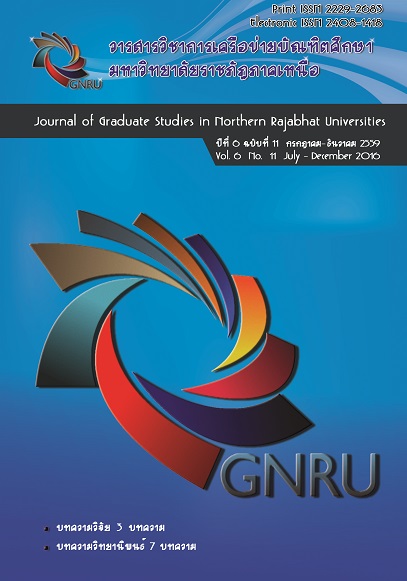การพัฒนารูปแบบการเรียนการสอนโครงงาน เพื่อเสริมสร้างความคิดสร้างสรรค์ทางวิทยาศาสตร์ สำหรับนักเรียนระดับประกาศนียบัตรวิชาชีพ สาขาช่างอุตสาหกรรม; The Developing of Project Teaching Style Enhancing Scientifically Creative Thinking for Industrial Trades Certif
Main Article Content
Abstract
บทคัดย่อ
การวิจัยครั้งนี้มีวัตถุประสงค์เพื่อ 1) สร้างและประเมินรูปแบบการเรียนการสอนโครงงานเพื่อเสริมสร้างความคิดสร้างสรรค์ทางวิทยาศาสตร์ 2) ศึกษาผลการใช้รูปแบบการเรียนการสอนโครงงานเพื่อเสริมสร้างความคิดสร้างสรรค์ทางวิทยาศาสตร์ ขั้นตอนการวิจัยมี 1) สร้างและประเมินรูปแบบ 2) ทดลองใช้รูปแบบ ขั้นสร้างและประเมินรูปแบบมี 8 ขั้นตอนย่อย คือ 1) ศึกษาข้อมูลพื้นฐาน 2) กำหนดองค์ประกอบ 3) สร้างรูปแบบฉบับร่าง 4) วิพากษ์รูปแบบ 5) ปรับปรุงแก้ไขรูปแบบ 6) ประเมินรูปแบบ 7) ทดลองนำร่อง 8) แก้ไขปรับปรุง เพื่อให้ได้รูปแบบที่สมบูรณ์ ขั้นทดลองใช้มี 7 ขั้นตอนย่อยคือ 1) สร้างและหาคุณภาพของแผนฯ 2) สร้างและหาคุณภาพ ของแบบทดสอบวัดการทำโครงงาน แบบทดสอบวัดความคิดสร้างสรรค์ทางวิทยาศาสตร์ 3) คัดเลือกกลุ่มตัวอย่าง 4) ทดสอบก่อนเรียน 5) จัดการเรียนการสอน 6) ทดสอบหลังเรียน 7) สรุปผลการทดลอง กลุ่มตัวอย่างเป็นนักเรียนระดับ ปวช.2 ช่างไฟฟ้า จำนวน 36 คน ใช้แบบแผนการทดลองกลุ่มเดียววัดผลก่อนและหลังทดลอง สถิติการทดสอบ t –test (Dependent sample test) พบว่า
1. รูปแบบการเรียนการสอนการเรียนการสอนโครงงานเพื่อเสริมสร้างความคิดสร้างสรรค์ทางวิทยาศาสตร์ ประกอบด้วย 6 องค์ประกอบคือ 1) ความเป็นมาและความสำคัญ 2) ทฤษฏีและแนวคิดที่เกี่ยวข้อง 3) หลักการของรูปแบบ 4) จุดประสงค์ของรูปแบบ 5) กระบวนการของรูปแบบ และ 6) การวัดและประเมินผล กระบวนการของรูปแบบประกอบด้วย 5 ขั้นตอน 1) สร้างความสนใจ (ส1) 2) สร้างความคิด (ส2) 3) สืบหาความจริง (ส3) 4) สรุปความรู้ (ส4) 5) สร้างสรรค์นวัตกรรมเพื่อเผยแพร่ (ส5)
2. นักเรียนระดับประกาศนียบัตรวิชาชีพ สาขาช่างอุตสาหกรรม ที่ได้รับการจัดการเรียนการสอน ตามรูปแบบที่ได้พัฒนาขึ้น มีความคิดสร้างสรรค์ทางวิทยาศาสตร์หลังเรียนสูงกว่าก่อนเรียนอย่างมีนัยสำคัญทางสถิติที่ระดับ .05
3. นักเรียนระดับประกาศนียบัตรวิชาชีพ สาขาช่างอุตสาหกรรม ที่ได้รับการจัดการเรียน การสอนตามรูปแบบที่ได้พัฒนาขึ้น มีความสามารถในการทำโครงงานวิทยาศาสตร์หลังเรียน สูงกว่าก่อนเรียน อย่างมีนัยสำคัญทางสถิติที่ระดับ .05
Abstract
The purposes of this research study were two folds: 1) to design and evaluate the results of the application of the project teaching style 2) to analyze the results of the application of the project. There were 2 steps in research; the first step was to design and to develop the project. The second step was to use the project. In the first step; it comprised 8 processes 1) to review the literature & analyze and to interpret data 2) to define factors 3) to design the model 4) to interpret the model 5) to improve the model 6) to evaluate the model 7) to test the model 8) the model is full. In the second step, it comprised 7 processes; 1) to design and evaluate the quality of the lesson plan. 2) to design and evaluate the quality of the project competence test and creative thinking test. 3) to select the experimental group. 4) to use pre-test 5) to use the project teaching. 6) to use post-test. 7) to conclude the research. The experimental group as 36 electrician certificate students were used One Group Pre Test–Post design used t-test (Dependent sample test). It found that.
1.The designed project comprised 6 factors. 1) Historical Background and the significant 2) Theories 3) Principles 4) Purpose 5) Process 6) Evaluation. Furthermore, the project comprised 5 process, Interest (I1), Step2:Idea Finding(I2), Step3:Inquire(I3), Step4:Inquest(I4) Step5: Innovative diffusion respectively(I5).
2. The participants outcome in using the designed project showed that the scientifically creative thinking in students was significantly high at 0.5. The project competence was significantly high at 0.5.


